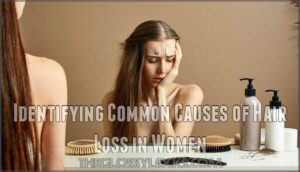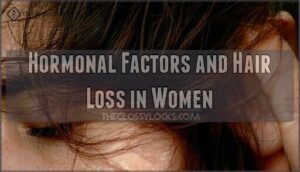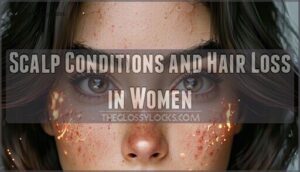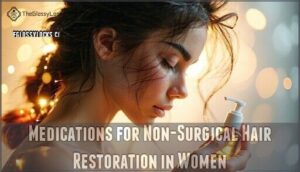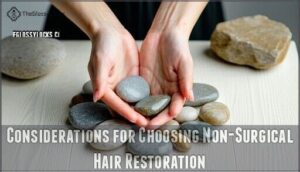This site is supported by our readers. We may earn a commission, at no cost to you, if you purchase through links.
 You’re not powerless against hair loss.
You’re not powerless against hair loss.
Non-surgical hair loss treatment options for women include FDA-approved minoxidil (Rogaine), which stimulates follicles and slows thinning.
Low-level laser therapy devices boost cellular activity in your scalp.
Prescription medications like spironolactone block hormones that trigger hair loss.
Nutritional supplements containing iron, biotin, and saw palmetto support healthy growth.
Scalp massages improve circulation, while specialized shampoos reduce inflammation.
Hormone therapy can rebalance estrogen levels if that’s your culprit.
Many women combine treatments for better results.
Each option works differently, so understanding your specific hair loss pattern becomes essential for choosing the right approach.
Table Of Contents
- Key Takeaways
- Understanding Hair Loss in Women
- Identifying Common Causes of Hair Loss in Women
- Hormonal Factors and Hair Loss in Women
- Scalp Conditions and Hair Loss in Women
- Lifestyle and Hair Loss in Women
- Non-Surgical Hair Replacement Options for Women
- Medications for Non-Surgical Hair Restoration in Women
- Light Therapy for Non-Surgical Hair Restoration in Women
- Considerations for Choosing Non-Surgical Hair Restoration
- Frequently Asked Questions (FAQs)
- What is the most effective treatment for female hair loss?
- Can hair grow back after thinning female?
- How to accept hair loss for females?
- What are the best non-surgical hair loss treatments?
- How can I help female hair loss?
- What are the best non-surgical options for thinning hair?
- Are there any side effects?
- What are the best treatments?
- How much do they cost?
- How quickly do they work?
- Conclusion
Key Takeaways
- Multiple FDA-approved treatments work effectively – You can choose from minoxidil (Rogaine), low-level laser therapy, spironolactone, and specialized supplements that target different causes of hair loss
- Early intervention produces better results – You’ll see more significant improvement when you start treatment as soon as you notice thinning, since dormant follicles respond better than severely damaged ones
- Combination approaches often work best – You can enhance your results by combining treatments like minoxidil with laser therapy or supplements, since they target hair loss through different mechanisms
- Consistency and patience are essential – You’ll need to stick with your chosen treatment for 3-6 months minimum to see noticeable results, and you’ll need to continue treatment long-term to maintain your progress
Understanding Hair Loss in Women
Hair loss affects over 20 million women in the United States, making it far more common than most realize.
You’re experiencing a natural response to various internal and external factors that disrupt your hair’s growth cycle.
Female pattern baldness represents the most prevalent form of female hair loss, typically manifesting as gradual hair thinning across the crown and part lines.
Unlike men’s hair loss patterns, women rarely develop complete bald spots but instead notice overall density reduction.
Hair loss causes in women stem from multiple sources including hormone balance disruptions, genetics, stress, and nutritional deficiencies.
Your scalp health plays a vital role in maintaining strong follicles and supporting healthy growth conditions.
Understanding these underlying mechanisms empowers you to explore targeted hair loss treatment options.
Non-surgical options offer effective alternatives without the risks associated with invasive procedures.
Many women hair loss treatments can restore confidence while addressing root causes rather than simply masking symptoms.
Identifying Common Causes of Hair Loss in Women
Before exploring treatment solutions, you’ll need to understand what’s causing your hair loss in the first place.
Identifying the root cause helps determine which non-surgical options will work best for your specific situation, and this is crucial for finding the right treatment.
Hormonal Imbalances
Throughout your reproductive years and beyond, shifting hormone levels can trigger female pattern hair loss.
Estrogen levels naturally decline during menopause effects, while androgen balance becomes disrupted, accelerating hair thinning solutions needs.
Thyroid issues compound these problems by disrupting your hair’s growth cycle.
Understanding these hormonal hair loss triggers helps you choose effective hair loss treatment options customized to your body’s changing needs.
Women experiencing hormonal hair loss can find more information on hormone replacement therapy as a potential solution.
Nutritional Deficiencies
The nutrients you consume directly influence your hair’s health and growth cycle.
Iron deficiency ranks among the most common causes of hair thinning in women, as iron carries oxygen to hair follicles.
Protein deficit weakens hair structure since hair consists primarily of keratin protein.
Vitamin deficiencies, particularly biotin and vitamin D, disrupt normal hair production.
Mineral imbalance affects cellular processes essential for hair growth.
Zinc supplements and targeted nutritional supplements can restore deficient levels and support healthier hair growth patterns.
Hormonal Factors and Hair Loss in Women
Your hormones play a vital role in maintaining healthy hair growth throughout your life.
Understanding your hormone balance is key to preventing and treating hair loss effectively.
When estrogen levels drop, androgen sensitivity increases, or thyroid function becomes imbalanced, you’ll likely notice changes in your hair’s thickness, texture, and overall health.
Estrogens Role in Hair
Estrogen levels play a protective role in your hair’s health by extending the growth phase and maintaining follicle strength.
When estrogen levels drop during menopause or hormonal changes, you may notice female pattern thinning or slower hair growth stimulation.
Hormone balance becomes critical for maintaining healthy locks.
Estrogen therapy can help restore ideal levels, supporting non surgical hair restoration efforts.
Many women’s hair loss treatments focus on rebalancing these hormones to encourage natural hair growth and prevent further thinning in female hair restoration programs, which can be part of a broader approach to hair restoration.
Androgen Sensitivity Effects
The interplay between Genetic Factors and Hormone Balance creates a complex landscape where your Hair Follicle responds to androgenic influences.
DHT binding triggers miniaturization in genetically predisposed follicles, causing androgenetic alopecia progression despite normal hormone levels.
Understanding the process of hair follicle miniaturization is essential for effective treatment.
- Sensitivity Testing reveals individual DHT responsiveness patterns for targeted female hair restoration approaches
- Hormonal changes during menopause amplify androgen effects when estrogen protection declines naturally
- Non surgical options like antiandrogen therapy block DHT receptors without systemic hormone disruption
- Hair loss treatment effectiveness improves when addressing both genetic predisposition and hormonal triggers simultaneously
Thyroid Hormone Imbalances
Thyroid dysfunction disrupts your hair’s natural growth cycle.
Hypothyroidism causes brittle, thinning hair, while hyperthyroidism triggers excessive shedding.
Autoimmune disorders like Hashimoto’s compound these hormonal changes. Regular thyroid tests help identify imbalanced hormone levels.
Thyroid medication restores function, making it essential for effective hair loss treatment and hair loss prevention.
Understanding the connection between thyroid disorders and hair loss requires knowledge of thyroid hair loss to develop effective treatment strategies.
Scalp Conditions and Hair Loss in Women
Beyond hormonal influences, your scalp’s condition directly impacts hair growth and retention. Scalp health forms the foundation for healthy hair follicles, and various conditions can disrupt this delicate ecosystem.
Your scalp is the soil where healthy hair grows—nurture it well for stronger, fuller locks.
Scalp inflammation represents one of the most common culprits behind hair thinning in women. When your scalp becomes inflamed, it restricts blood flow to hair follicles, limiting nutrient delivery and weakening hair structure. This process can accelerate female pattern hair loss and create additional thinning patterns.
Several scalp conditions frequently contribute to hair loss causes in women:
- Seborrheic dermatitis creates flaky, oily patches that can clog follicles and impede growth
- Scalp psoriasis produces thick, scaly plaques that damage follicles and cause breakage
- Folliculitis involves infected or inflamed follicles that disrupt the normal growth cycle
Understanding these conditions helps you select appropriate non surgical hair restoration approaches. Many womens hair loss treatments and hair loss treatment options for women work more effectively when underlying scalp issues are addressed first, creating ideal conditions for treatment success.
Lifestyle and Hair Loss in Women
Your daily habits can make or break your hair health journey. While scalp conditions create visible problems, lifestyle factors work behind the scenes to influence your hair’s strength and growth potential.
Stress management becomes your first line of defense against hair loss. Chronic stress disrupts your hair’s natural growth cycle, pushing follicles into premature shedding phases. Finding effective stress-busting techniques – whether through meditation, yoga, or simple breathing exercises – helps maintain healthy hair cycles.
Your diet impact extends far beyond general wellness. Hair follicles need specific nutrients like iron, protein, and B vitamins to function properly. Poor nutrition starves your follicles, leading to weak, brittle strands that break easily.
Sleep patterns directly affect hormone production, including those regulating hair growth. Aim for seven to eight hours nightly to support ideal follicle function.
A regular exercise routine improves blood circulation to your scalp, delivering essential nutrients to hair roots. Even moderate activity makes a difference.
Proper hair care prevents unnecessary damage through gentle handling, appropriate products, and protective styling. These women’s hair loss treatments and non-invasive treatments work best when combined with healthy lifestyle choices.
Non-Surgical Hair Replacement Options for Women
While lifestyle changes can help slow hair loss, you’ll find immediate relief through non-invasive treatments designed specifically for women’s hair restoration needs.
These hair replacement options give you control over your appearance without surgical risks.
Hair replacement systems offer sophisticated solutions that work around your schedule and preferences:
- Hair Pieces and wigs – Custom-fitted options using human or synthetic hair that attach securely with medical-grade adhesives, lasting up to one year with proper maintenance.
- Scalp Micropigmentation – Specialized tattooing technique creating realistic hair follicle patterns, particularly effective for thinning areas and lasting up to five years.
- Hair Fibers and hair thickening products – Keratin-based fibers that bond to existing hair strands, providing instant volume that’s water-resistant and sweat-proof for up to 12 hours.
- Hair growth supplements – Targeted nutritional support containing biotin, iron, and other follicle-supporting compounds that complement other treatments.
These women’s hair restoration methods can be combined for enhanced results, giving you flexibility to customize your approach based on your specific hair loss pattern and lifestyle requirements.
Understanding female hair growth solutions is essential for making informed decisions about your hair restoration journey.
Medications for Non-Surgical Hair Restoration in Women
Medications represent your first line of defense against female pattern hair loss, offering scientifically proven results without surgical intervention. Minoxidil therapy stands as the gold standard for women hair growth, with FDA approval backing its treatment efficacy.
You’ll find two concentrations available: 2% and 5% formulations, with the higher strength typically delivering superior hair regrowth methods for most women. When you apply minoxidil directly to your scalp once or twice daily, it works by increasing blood flow to hair follicles and extending the growth phase of your hair cycle.
This hair loss treatment requires consistency – skipping applications means losing progress you’ve made. Beyond topical minoxidil, oral versions offer systemic benefits but require careful monitoring due to potential blood pressure effects. Medication safety becomes paramount here, as some treatments like finasteride aren’t recommended for women of childbearing age.
Hair growth supplements containing biotin, iron, and other nutrients can support your medication regimen, though they work best as complementary treatments rather than standalone solutions for addressing underlying hormonal causes. For effective minoxidil therapy products are essential to include in your treatment plan.
Light Therapy for Non-Surgical Hair Restoration in Women
Light therapy offers a promising non-invasive solution when medications aren’t your preferred route. Low level laser therapy (LLLT) uses red light wavelengths between 650-675 nm to stimulate dormant hair follicles through photobiomodulation. This process increases cellular energy production and extends the hair growth phase.
Laser treatment devices include caps, combs, and handheld units designed for home use. Clinical studies show laser therapy can increase terminal hair counts by 37% in women with androgenetic alopecia after 16 weeks of every-other-day treatment.
LLLT for hair loss works by improving blood circulation to your scalp and potentially reducing DHT levels. These non invasive treatments require patience—you’ll typically see results after 3-4 months of consistent use.
Laser hair loss treatments are well-tolerated with no reported side effects, making them suitable for women who can’t use medications. The convenience of at-home treatment puts you in control of your hair growth journey. Understanding the various hair regrowth options is essential for making informed decisions about your hair loss treatment.
Considerations for Choosing Non-Surgical Hair Restoration
Choosing the right non-surgical hair restoration treatment requires careful evaluation of your specific needs and circumstances.
You’ll want to take into account your personal goals, the safety and effectiveness of different options, and the financial and time investment each treatment requires, considering the effectiveness of each.
Personal Goals and Preferences
Your hair expectations should match realistic outcomes from noninvasive hair treatments.
Consider these key factors when selecting womens hair restoration options:
- Personal Style preferences for coverage versus natural density
- Lifestyle Choices affecting treatment compliance and maintenance schedules
- Confidence Boost goals you’re hoping to achieve
- Beauty Standards that matter most to you personally
Hair loss solutions for women work best when they align with your individual needs and hair loss prevention techniques fit your routine.
Effective hair regrowth treatment options can substantially improve the success of these solutions.
Treatment Efficacy and Safety
Understanding Treatment Outcomes helps you make informed decisions about women’s hair loss solutions.
Research shows 5% minoxidil achieves superior hair restoration for women compared to placebo, with measurable improvements after 48 weeks.
However, noninvasive hair treatments carry varying Efficacy Rates and potential Side Effects that require careful consideration.
When exploring minoxidil treatment options, it’s vital to bear in mind the minoxidil treatment effects on scalp health.
| Treatment Type | Efficacy Rate | Common Side Effects |
|---|---|---|
| 5% Minoxidil | Superior to placebo | Scalp irritation, unwanted facial hair |
| LLLT | Effective for androgenic alopecia | No systemic effects reported |
| PRP Therapy | Reduced shedding, improved density | Injection-site discomfort only |
Safety Measures matter when selecting hair loss treatment efficacy options.
Success Stories demonstrate that combining treatments often produces better results than single approaches alone.
Cost and Time Commitment
Budget considerations will shape your treatment timeline and expectations.
Non-surgical options range from affordable daily applications to premium laser devices requiring significant upfront investment.
- Treatment Costs vary from $20 monthly for minoxidil to $3,000 for professional laser therapy systems
- Time Investment ranges from 5-minute daily applications to weekly clinic visits spanning months
- Financial Planning should account for ongoing maintenance expenses and potential combination therapies
- Cost Effectiveness improves with consistent use – sporadic treatment wastes money and delays results
- Maintenance Schedules require lifelong commitment for sustained hair loss prevention tips and continued improvement
Understanding the long-term effects of laser hair treatment is essential for making informed decisions about non-surgical hair restoration.
Frequently Asked Questions (FAQs)
What is the most effective treatment for female hair loss?
You’ll find minoxidil most effective for preventing further loss when applied daily to your scalp. Low-level laser therapy also shows promising results for improving hair density and thickness in women.
Can hair grow back after thinning female?
Yes, your thinning hair can regrow through various treatments. Minoxidil, laser therapy, and stress management effectively reactivate dormant follicles. Early intervention yields better results, so don’t wait to start treatment.
How to accept hair loss for females?
Accepting hair loss starts with reframing your mindset – you’re not losing something, you’re gaining freedom from societal beauty standards.
Focus on your unique qualities beyond hair.
Consider stylish scarves, hats, or embrace the bold look completely.
What are the best non-surgical hair loss treatments?
You’ll find minoxidil, low-level laser therapy, and scalp micropigmentation work best. These treatments stimulate follicles, improve thickness, and create natural-looking results without surgery’s risks or downtime.
How can I help female hair loss?
Like nurturing a garden back to bloom, you can revive thinning hair through proven treatments.
Low-level laser therapy stimulates dormant follicles, while minoxidil prevents further loss.
Microneedling and stress management also promote healthy regrowth effectively.
What are the best non-surgical options for thinning hair?
You’ll find excellent results with minoxidil, low-level laser therapy, scalp micropigmentation, hair thickening fibers, and microneedling.
These proven treatments stimulate growth, create fullness, and restore confidence without surgery’s risks or downtime.
Are there any side effects?
Most non-surgical hair treatments carry minimal side effects.
You might experience mild scalp irritation from topical treatments like minoxidil, temporary redness from laser therapy, or allergic reactions to adhesives used with hairpieces, which can be considered a complete concept in the context of non-surgical hair treatments.
What are the best treatments?
You’ll find the most effective treatments combine Low Level Laser Therapy, minoxidil applications, and microneedling sessions. These evidence-based options stimulate dormant follicles while preventing further loss progression.
How much do they cost?
Costs vary like puzzle pieces in your budget – you’ll spend $200-3,000 annually for minoxidil, laser therapy, or micropigmentation, while hairpieces range $500-2,500 depending on quality and maintenance needs.
How quickly do they work?
Results vary by treatment method. You’ll see hair thickening fibers work immediately, minoxidil shows progress in 3-6 months, while laser therapy and microneedling require 6-12 months for noticeable improvement.
Conclusion
Twenty-five million American women face hair loss by age fifty, yet many feel their confidence slipping away like sand through fingers.
Your journey doesn’t end with thinning hair. Multiple non-surgical hair loss treatment options for women exist to restore your confidence and hair health.
From FDA-approved minoxidil to laser therapy devices, you’ve got science-backed solutions at your fingertips. Consult your healthcare provider to create a personalized treatment plan that addresses your specific needs and lifestyle.
- https://www.health.harvard.edu/staying-healthy/treating-female-pattern-hair-loss
- https://pmc.ncbi.nlm.nih.gov/articles/PMC10334345/
- https://drmedispa.com/treatments/hair-loss-treatments-non-surgical/
- https://www.dermatologytimes.com/view/prp-therapy-shows-promise-for-female-hair-loss
- https://www.youtube.com//videos

